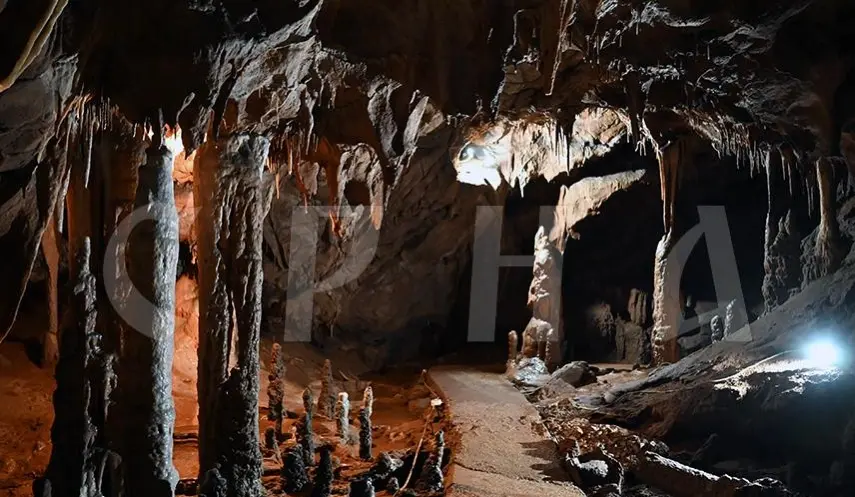ORLOVAČA CAVE - A TOURIST GEM SOON TO BE OPEN TO VISITORS
Republika Srpska - Pale - tourism
05/01/2025
12:57

PALE, APRIL 30 /SRNA/ – Orlovača Cave, located in Sumbulovac near Pale and stretching two and a half kilometers with its unique cave formations, will soon be open to visitors, Nebojša Džakić, a guide at this natural monument, told SRNA.
Orlovača Cave is situated in the western part of the Romanija arch in the catchment of the Mokranjska Miljacka River, specifically on its right tributary, the Sinjeva.
The cave entrance is located at the base of a hill and the cave itself is two and a half kilometers long, while the length of the tourist path is approximately 565 meters.
Džakić explained that the cave lies along the Pale–Sokolac road in the village of Sumbulovac. Visitors can reach a small building with a souvenir shop and the Orlovača Museum by paved road, and the cave is located just above.
According to him, Orlovača Cave was declared a natural monument in 2011 and falls under the third category of international classification with a secondary protection regime.
The cave is considered one of the most important tourist and speleological sites.
Džakić noted that the charm of Orlovača Cave is exceptional and inspires awe and admiration in visitors.
"It is a unique gem created by a divine hand, and its formations are one-of-a-kind," said Džakić.
He explained that inside the cave there are beautiful stalagmites, stalactites, and coral-like aragonite formations, as well as cave columns that resemble Renaissance castles and monuments of various shapes and colors.
CAVE FAUNA
Several species of bats live in the cave — including small and large horseshoe bats, and the common pipistrelle.
Džakić said that bat monitoring is currently underway, and over 50 individual small horseshoe bats have been found in just the tourist section of the cave — a species that has disappeared from much of Europe.
"Our bat colonies are growing, and bats are extremely useful to humans as they can consume several hundred mosquitoes and harmful insects in one feeding session, so they should be protected," he explained.
He emphasized that bats are on the red list of endangered species and are under strict protection.
REMOVING ROCK BLOCKS THAT POSED A SAFETY RISK
Džakić emphasized that Orlovača Cave had been closed to visitors for two years due to safety concerns.
During that time, the management of the Pale Cultural and Sports Center worked diligently to remove rock blocks hanging precariously from the cave ceiling.
The center followed preliminary recommendations by Aleksandar Golijanin and began removing the blocks one by one. They are now close to completing this work.
"This is a protected natural site. For everything we do, we must consult the Republic Institute for the Protection of Cultural, Historical, and Natural Heritage. They must approve every project or modification near the cave," said Džakić.
New lighting is currently being installed in the cave that will not disturb the microclimate or affect the bats. Emergency lighting has also been added in case of power outages, ensuring safe exits.
"The most important aspect of visiting any natural site is to enter and exit safely," Džakić emphasized, adding that helmets are prepared for visitors and a liability waiver must be signed before entering the cave.
MUSEUM WITH BEAR BONES AND SOUVENIRS
Below Orlovača Cave, in a well-equipped visitor center, guests can see a longitudinal section of a stalagmite, paleontological remains of a cave bear — a species that went extinct 10,000 to 12,000 years ago.
The bones found in the cave are estimated to be over 16,000 years old.
That estimate was made by paleontologist Mirko Malez from the Yugoslav Academy of Sciences and Arts in Zagreb. Some parts of the skeleton are kept in the Croatian capital, while others are in the National Museum.
Džakić added that in addition to bear bones, there are illustrations showing the bear's size compared to a human — these bears could weigh up to 1,500 kilograms.
"They lived in the cave full time, only going out to feed. All the bones were found inside, along the tourist trail. The largest bones were discovered in the final tourist chamber, `Romanija,` embedded in rocks deposited by floodwaters," said Džakić.
He noted that water used to flow through the cave.
Džakić said that the museum also includes illustrations of the endemic bat species and a detailed map of the entire cave, from the entrance chamber to the Romanija Hall. The tourist section consists of 14 segments, nine of which are currently accessible.
With its rare decorations shaped by chemical and mechanical effects of water, Orlovača is considered one of the most beautiful caves in Republika Srpska and BiH.






